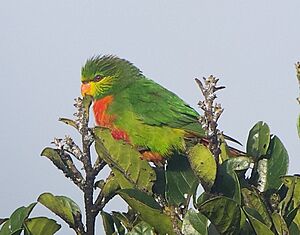Orange-billed lorikeet facts for kids
Quick facts for kids Orange-billed lorikeet |
|
|---|---|
 |
|
| Conservation status | |
| Scientific classification | |
| Genus: |
Neopsittacus
|
| Species: |
pullicauda
|
| Synonyms | |
|
|
The orange-billed lorikeet (Neopsittacus pullicauda) is a type of parrot found only in New Guinea. It lives in high mountain areas, usually in misty cloud forests or at the edges of woodlands. These birds are often found at heights between 2,100 and 3,800 meters (about 6,900 to 12,500 feet).
Adult orange-billed lorikeets are about 18 centimeters (7 inches) long. They weigh between 25 and 40 grams (about 0.9 to 1.4 ounces). They are mostly green with a red belly and yellow stripes on their cheeks. Their beak and eyes are orange. They look a lot like their close relative, the yellow-billed lorikeet, but they are smaller. They also have brighter colors and a smaller, orange beak.
These lorikeets eat pollen, nectar, flowers, and fruits. Sometimes, they also eat seeds. They might feed with yellow-billed lorikeets in fruit trees. However, they usually don't mix with other types of birds. They lay two eggs in nests made in tall trees, usually in October. The orange-billed lorikeet is not considered endangered. This is because it lives in a large area and its population is stable.
Contents
About the Orange-billed Lorikeet
The orange-billed lorikeet was first officially described in 1896. This was done by a German bird expert named Ernst Hartert. He studied birds from the Owen Stanley Range in New Guinea. The name Neopsittacus comes from Greek words meaning "new parrot." The name pullicauda comes from Latin words meaning "dark-colored tail."
Sometimes, this bird is called the emerald lorikeet or alpine lorikeet. Birds from different parts of New Guinea can look slightly different. For example, birds from the western areas might be smaller and paler.
The orange-billed lorikeet is one of two species in the group called Neopsittacus. The other is the yellow-billed lorikeet. These two birds are related to many other lorikeet types.
What They Look Like
The orange-billed lorikeet is a small bird. It measures about 18 centimeters (7 inches) long. It weighs between 25 and 40 grams (0.9 to 1.4 ounces). Most of its body is a dark emerald green. Its belly is red, and it has thin yellow stripes on its cheeks.
Their sides and wings are also emerald green. The underside of their tail is a duller green with a red spot at the base. When they fly, you can see their bright red underwings. Their eyes and beak are orange, and their beak has a yellow tip. Their feet are dark grey.
Young orange-billed lorikeets are not as brightly colored. They have less red on their bellies. Their beaks are orangish-brown. When they are very young, their beaks are yellow. They turn orange when the birds are about 6 months old.
The only other parrot that looks similar in their home area is the yellow-billed lorikeet. The orange-billed lorikeet is smaller and has richer colors. Its beak is also smaller and orange. You can also tell them apart because the orange-billed lorikeet's wings and sides are the same green color. Its tail is dull green with red at the base. It also doesn't have an olive tint on its head.
Their Calls
These birds are quite noisy. They make many different sounds. One common call is a high-pitched "tseet" sound that goes up. They also make other longer, high-pitched calls. Their calls are similar to the yellow-billed lorikeet's. However, they are usually softer, higher-pitched, and sound more like music.
Where They Live
The orange-billed lorikeet lives only on the island of New Guinea. They live in the high mountains of the Central Range and the Huon Peninsula. They are not found on the Bird's Head Peninsula.
They prefer cloud forests at high elevations, from 2,100 to 3,800 meters (6,900 to 12,500 feet). Sometimes, they are seen at lower elevations, around 800 meters (2,600 feet). This suggests they might move up and down the mountains at different times of the year. At lower heights, they often share areas with yellow-billed lorikeets.
What They Do
Orange-billed lorikeets usually live in small groups. They eat pollen, nectar, flowers, and fruits. They have been seen eating seeds from Papuacedrus papuana trees and berries from Sericolea pullei plants. They eat more nectar than yellow-billed lorikeets.
They sometimes feed with yellow-billed lorikeets in trees that have lots of fruit. But they rarely feed with other types of birds.
Reproduction and Life Cycle
The breeding season for orange-billed lorikeets is in October. They build their nests in hollows inside tall trees. A female usually lays two eggs at a time.
Like many birds, orange-billed lorikeets can have tiny insects living on them. These include different types of mites and chewing lice.
Conservation Status
The orange-billed lorikeet is listed as a species of "least concern" by the IUCN Red List. This means it is not currently threatened. It has a large range, and its population is not decreasing quickly.
It is also listed on Appendix II of CITES. This means that international trade of these birds is controlled. However, the species is common in most of its habitat. It is not greatly threatened by habitat loss or by being caught for the pet trade.


